You may have seen it before – the statistic that says email generates $38 for every $1 spent. Facebook ads, social media ads, and search engine marketing can’t compete.
As an Ecommerce brand, email marketing isn’t nice-to-have, it’s essential. Unfortunately, many brands don’t utilize ecommerce email marketing to its full potential.
So why does your e-store need email marketing and how do you create an email marketing campaign successfully? Our ecommerce email marketing guide will help you put the pieces of the puzzle together and launch successful email campaigns.
Table of Contents
What is eCommerce email marketing?
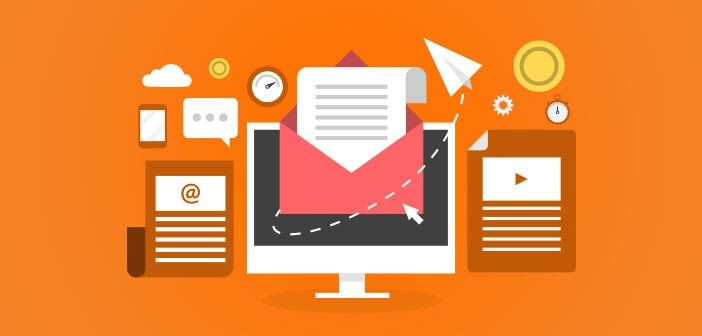
You might hear about the term “email marketing” somewhere, but exactly what is it, and is there any difference in email marketing in the eCommerce industry?
Email marketing is the practice of delivering messages to potential and existing customers via email for advertising, education, or relationship-building.
Its functionality is like an invisible bridge between the business and customers. In that relationship, businesses provide relevant, valuable information to their target audience for a specific marketing purpose.
When email marketing is applied in eCommerce, it allows store owners to generate more sales via multiple email campaigns and increase customer loyalty.
For example, sending an email to people who abandon their shopping carts. Or more complex sequences that have numerous campaigns working together to multiply sales exponentially.
Why email marketing is crucial to eCommerce success
86% of consumers prefer to receive a promotional email from brands they subscribe to at least once per month.
Some popular types of email which are used in eCommerce are promotional emails, personalized transaction emails, abandoned cart emails, discount emails, and so on.
An email marketing strategy can help you grow your business faster and drive real profitable results. If you haven’t taken the time to set up eCommerce email marketing platform properly, the information below may be the push you need.
Strengthen customer relationships
People tend to respond to content that seems to speak directly to them. Social media platforms are often a good choice to interact with customers. However, when it comes to converting people into members, customers, or supporters, email marketing is the way to go. It’s used to encourage a customer’s second purchase and beyond.
And why are repeat customers valuable?
One of the apparent reasons is the profitability of existing customers. The chance to resell to a repeat customer can be 50% higher than a prospect. What’s more, new customers will cost you 5 times more than retaining an existing customer.
To effectively manage and track the time spent on email marketing campaigns for your e-commerce business, consider utilizing time tracking for e-commerce tools.
Implementing a time reporting system can help you streamline the tracking process, analyze campaign efficiency, and allocate resources more effectively, ensuring optimal productivity and ROI.
These tools can help you measure the time spent on different aspects of your email marketing efforts, such as creating content, designing templates, and analyzing campaign performance.
By implementing time tracking for e-commerce, you can optimize your workflow, improve productivity, and ensure that your email marketing strategy is efficient and effective.
Beyond just managing campaigns, savvy e-commerce entrepreneurs are diving into the world of advanced e-commerce tools to supercharge their businesses. These powerhouses aren’t just about tracking time; they’re about revolutionizing how you connect with customers.
Imagine AI-driven product recommendation engines that feel like mind-reading, or chatbots that charm shoppers with personality while boosting sales.
Deliver a strong return on investment (ROI)
See what Shopify’s report said about its average order conversion rates by source:
- The conversion rate from email was 4.29% – the channel has the highest performance
- The conversion rate generated via search (3.04%) and via direct channels (2.93%)
- Social media had a 1.81% conversion rate
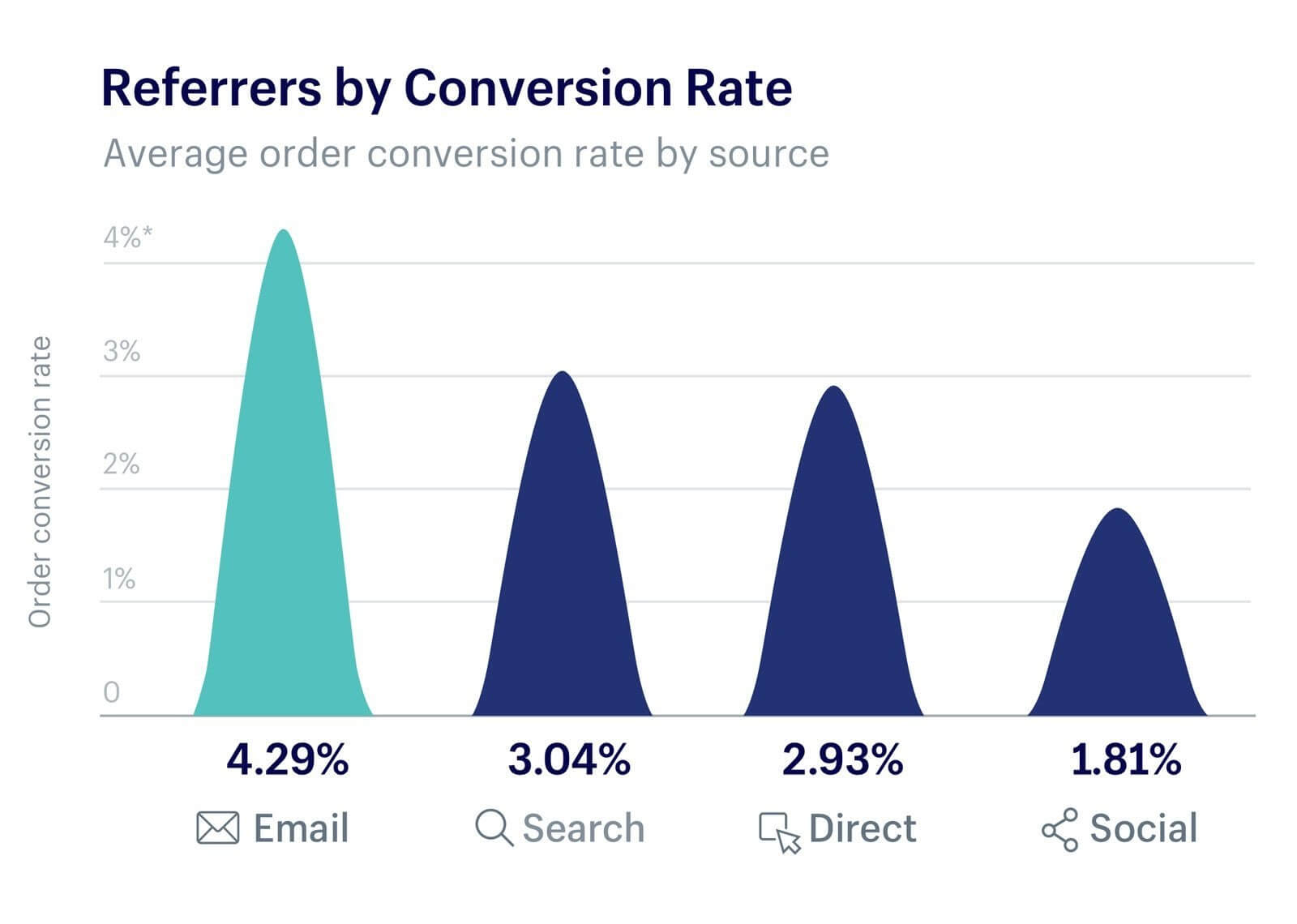
Influence three main growth multipliers
According to Jay Abraham (CEO of the Abraham Group), there are three ways to create exponential growth:
- Increase the number of customers
- Increase the average transaction value
- Increase the frequency that customers buy from you
Email marketing can positively impact all three growth multipliers at the same time.
How can email marketing be applied in each situation?
- Use automated welcome and abandoned cart emails to increase conversion rate, which focuses on both customer acquisition and retention
- Run lifecycle campaigns and broadcasts automatically to emphasize high-value items to the right customers
- Send promotion announcement emails to increase the purchase frequency customers
It seems impossible, but you can optimize all three areas via only one tool – email marketing. So it’s worth creating an email strategy for your online store for a boost in revenue and profits.
Unaffected by third-party gatekeepers
One outstanding ability of email marketing which makes it “immortal” is that email isn’t subject to the whims of centralized platforms.
To make this point easy to understand, we will take Facebook as an example. The organic reach has been failing since 2013 as it focuses non-stop on promoting users’ content for the News Feed. For brands, it’s Pay-To-Play
The same problem happens with Google as SEO is only getting more difficult as time progresses. To increase your rank to the top 10 in a fiercely competitive environment, you’re forced to pay – whether through a link building service or through Google Ads. Apparently, those costs are growing.
How to build a successful email marketing campaign for eCommerce
Step 1: Identify your customer segments
Identifying the target audience is one of the first steps to start any marketing campaign if you want it to work well. Segmented campaigns get 14.37% more opens and 64.78% more clicks than the non-segmented ones.
By targeting a specific audience for each campaign, you can reach the customers who will relate most to your brand’s message and products. The question here is how to segment your email marketing list for different campaigns?
Some segmentation strategies for you to consider:
- Segment by customer’s demographic
- Segment by engagement level of subscribers
- Segment by customer’s past purchase and average transaction size
- Segment by the customer’s position in the sales funnel
- Segment by subscribers’ interest and behavior in your web
With each segmentation strategy, you can apply multiple tactics to serve different marketing goals. The segmentation will depend heavily on the objectives you set for your email marketing plan.
Step 2: Know your audience
The second step requires you to answer the question: Who is your audience, and what does your email marketing plan aim at?
Then, build an in-depth audience persona.
Knowing your audience helps you figure out what content and messages they care about. You can state their pain points, challenges, and needs so clearly that it’s like you’re actually living in their head.
Below are three tips that help you get to know your customers:
- Analyze customer data: Look for the trends relating to buyer’s demographics and purchasing habits via your analytics tools and sale reports. You can also send out demographic surveys to ask questions directly.
- Build audience personas: Spend time building audience personas based on all the information you’ve gathered from customers.
- Check data from social pages: Take advantage of analytics from your social media accounts by looking at demographic and engagement data for new content ideas.
The more you know about your customers, the higher your chances of success.
Step 3: Build your email list
Simply put, an email list is a list of customers’ emails that businesses have collected from different channels. Even if you’ve already got a long list of emails for clients and prospects, you should never stop adding to it.
Below are 5 ways to start building your email list:
- Use a pop-up offer on the homepage
- Display an email sign-up form in your website’s navigation or footer
- Use a pop-up event with an incentive to collect visitor’s email addresses
- Include a CTA button on social media channels
The more ways you can encourage visitors to subscribe to your email, the stronger your email list will be.
Step 4: Send your email
Now, it seems like you can put your email marketing strategy to work at any moment. However, you should not miss the last step – arguably the most important.
It’s crucial to have a basic understanding of the laws and regulations around email marketing. By this, you can make sure your campaigns aren’t getting in trouble or breaking any laws.
- CAN-SPAM: The Controlling the Assault of Non-Solicited Pornography and Marketing Act, its power is to set rules around commercial email
- GDPR: The General Data Protection Regulation, created to protect the data privacy of all EU citizens
- CASL: Canadian Anti-Spam Legislation. Its subject is to protect Canadian users from spam, personal data leaks, and other types of digital technology misuse
Types of email marketing campaigns that increase engagement (with examples)
Welcome Email
A report by Invespcro shows that the average open rate for a welcome email is 50% and 86% more effective than the standard one.
A friendly hello can be a strong foundation for the relationship between you and your customers. Your welcome email should be informative, clear, and actionable. The welcome message should contain response and opt-out options and try not to send emails from no-reply addresses.
Cambly, for example, uses an offer of 5 free minutes as an incentive to encourage readers to try their classes.
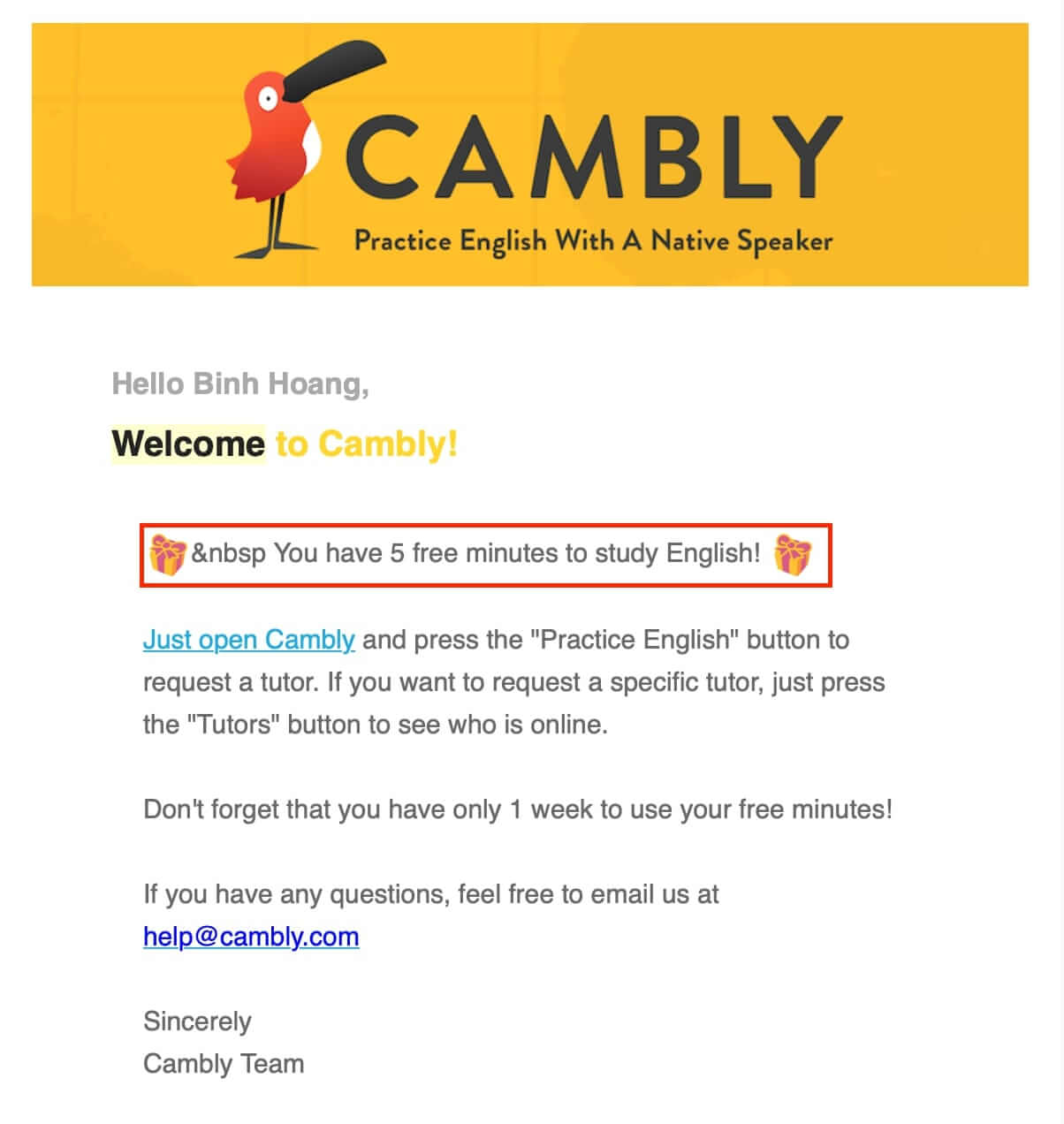
Curation Email
A curation email focuses on finding, organizing, and sharing the best and most relevant content on a specific topic with your audience. Businesses will find all their best materials, then gather them in one place and send it to the subscribers.
It’s an opportunity to offer subscribers a wide variety of tailored material. For example, look at the example from Crowne Plaza West Hanoi, which gathers all the noticeable promotions in a month to attract their customers.
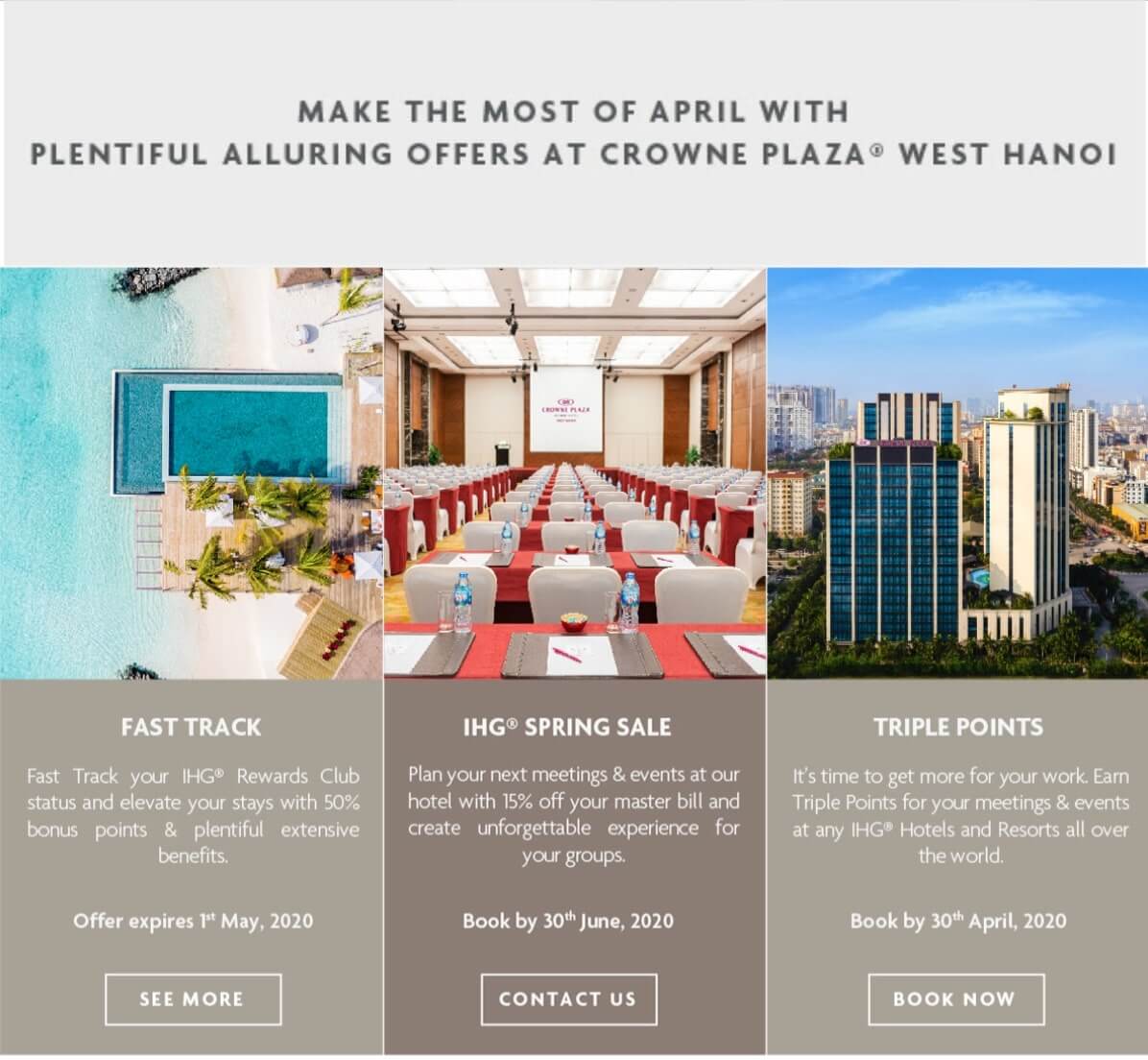
Engagement Email
Over a third (34%) of people who subscribe to email lists are lost within the first 30 days. Sooner or later, your subscribers will turn inactive, and that is an undeniable reality.
That’s why the engagement email is used to strengthen the relationship between companies and subscribers. Open rate, click rate, and conversion rate are the three most common email engagement metrics.
Lumen5 is a good example of using discounts to encourage engagement.
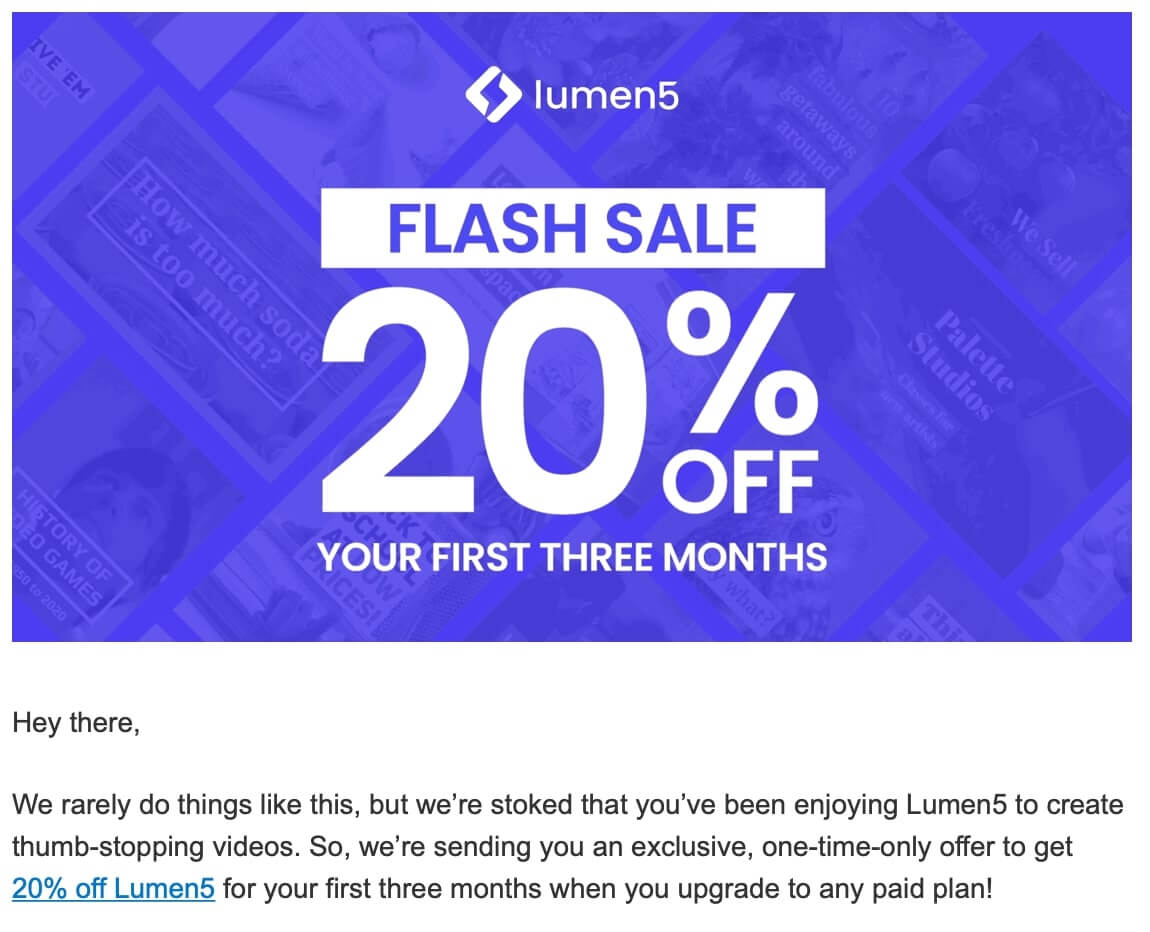
Referral Email
One way to increase your customer retention and acquisition rates is by sending out referral emails to your subscribers with a hard-to-resist incentive. The subscribers who receive your emails will refer your products to their friends and family in exchange.
Look at how EverlyWell company used email marketing to ask for referrals with a compelling incentive: 10% off for family and friends; 20$ for every purchased kit that was made via their code.
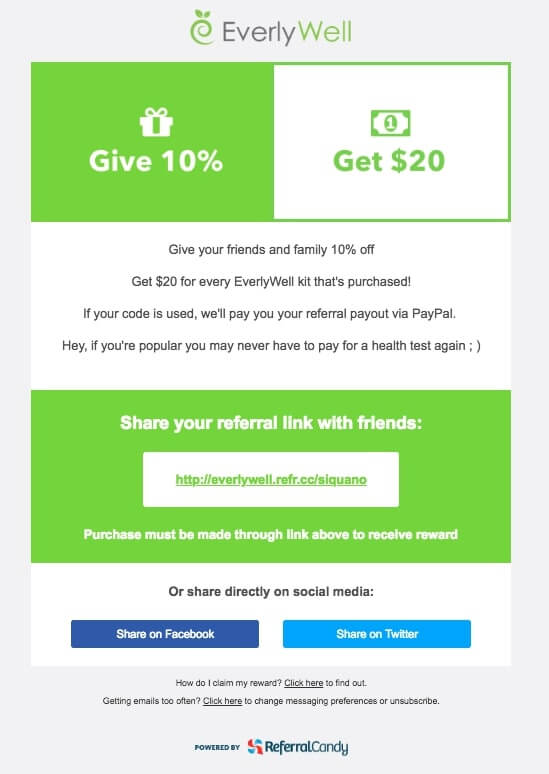
Discount Email
Promotional emails are a simple yet powerful way to spread the word about your products or services. Its goal is to increase awareness, generate revenue, or improve customer retention/ loyalty.
In fact, 49% of buyers would like to receive promotional emails from their favorite retail brands weekly. Below is an example of Ripl, a post-creation app that offers a 25% discount to entice customers to purchase more.
Note: Though discounting email is useful, don’t overdo it. If you send too many offers within a short time, customers might feel being bothered and annoyed. But too little, then you can risk driving customers to your competitors.
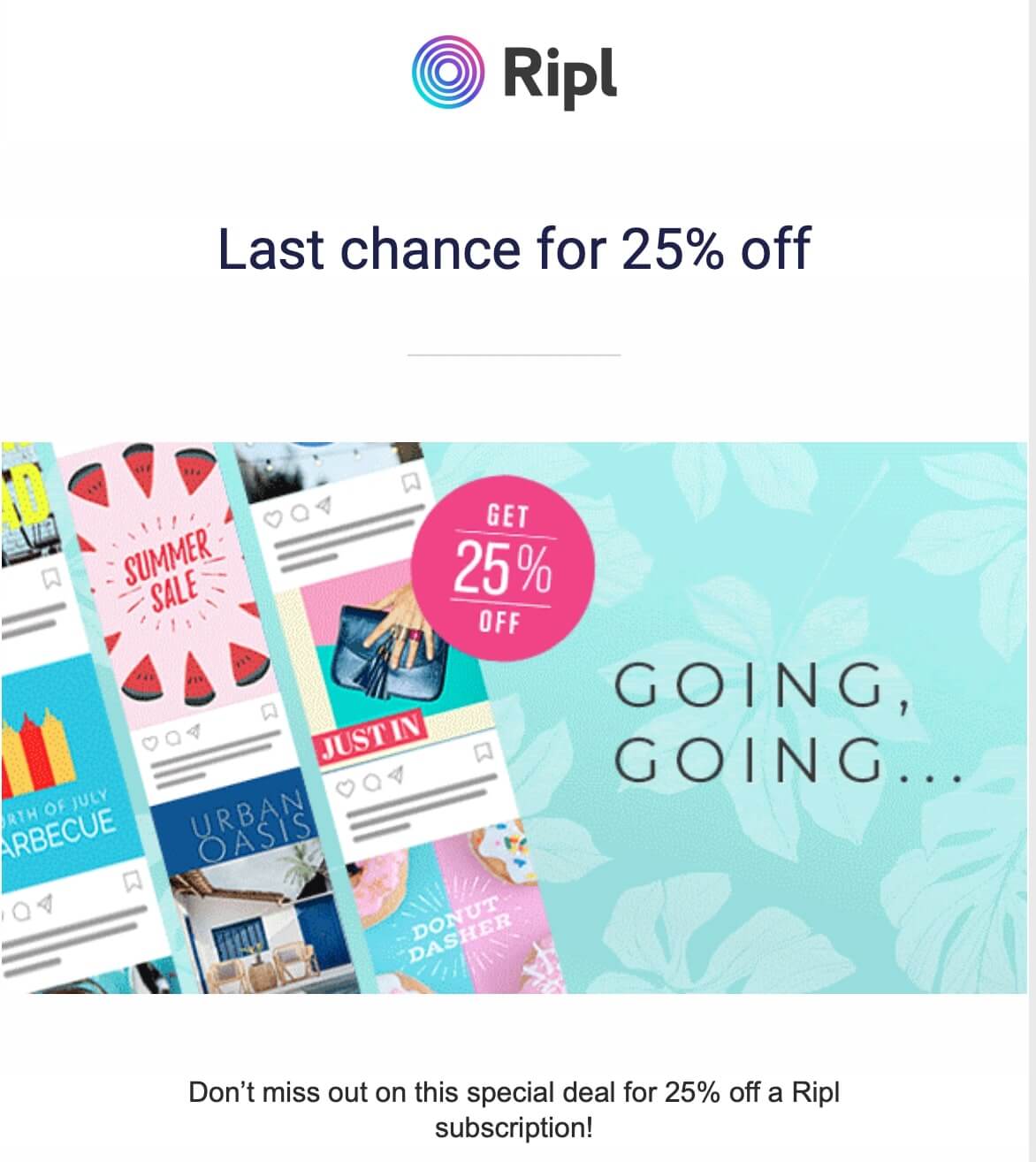
Cart Abandonment Email
According to SaleCycle, 75.6% of customers put items in their online shopping cart only to leave it without completing their purchase.
If eCommerce businesses don’t take any action to remind those shoppers about the forgotten items on their carts, they have lost a chance to gain a potential customer. If it’s not just one customer, but many, then how many sales could you lose?
An abandoned cart email is a follow-up email sent to someone who has added items to their cart, gets through a portion of the checkout, and then leaves the site without purchasing.
A perfect illustration of an abandonment email comes from Away:
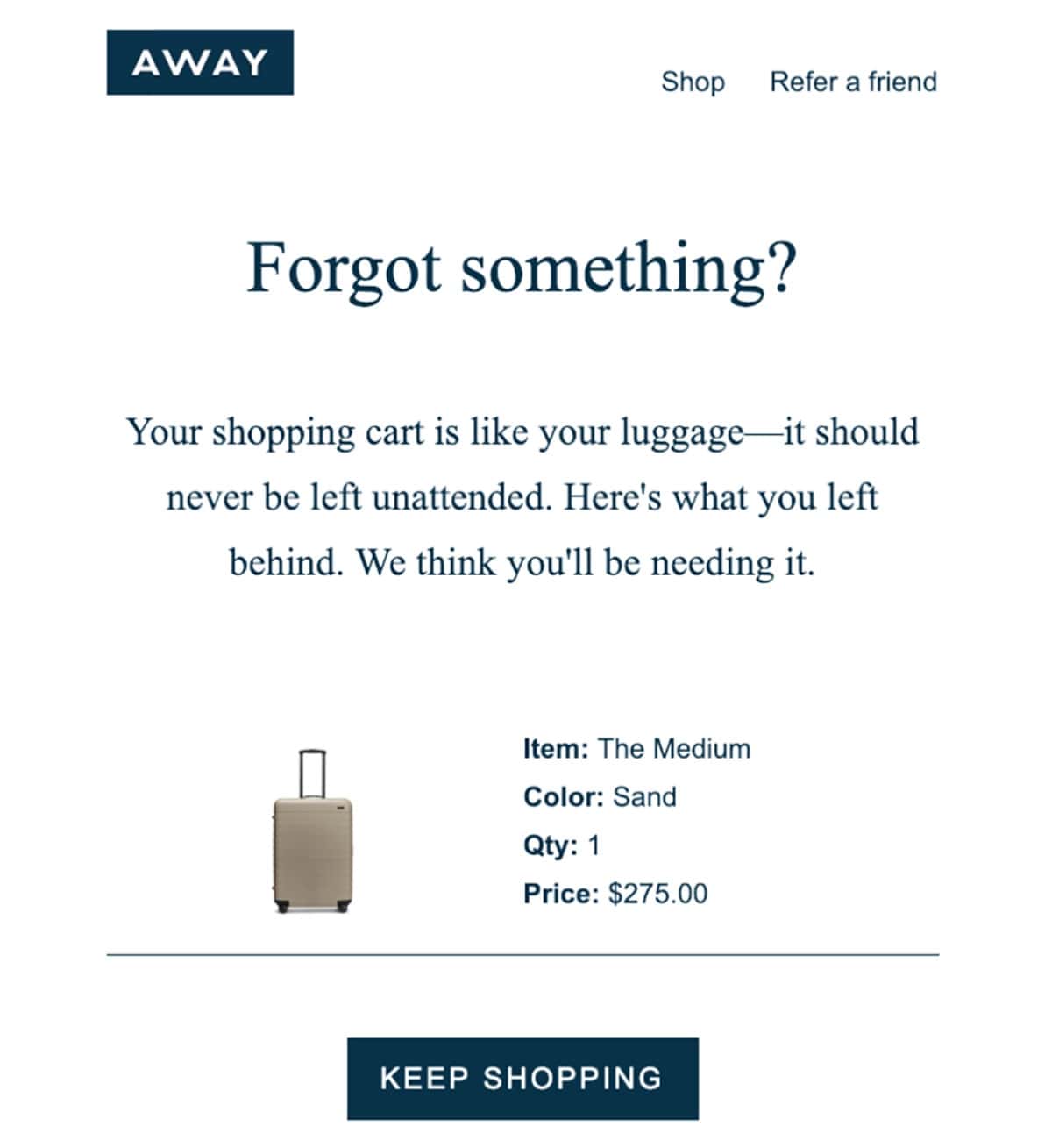
Order Confirmation Email
A survey by CM Commerce showed that every order confirmation email brings $0.25 in extra revenue to eCommerce stores. More to it, print on demand eCommerce stats shows that 64% of people say marketing emails influence their purchase decisions.
An order confirmation email is a transactional email notifying your buyers that you received their order. It contains important order information like price, shipping times, address, etc.
Here’s an example of an order confirmation email from clothing company Zalando:
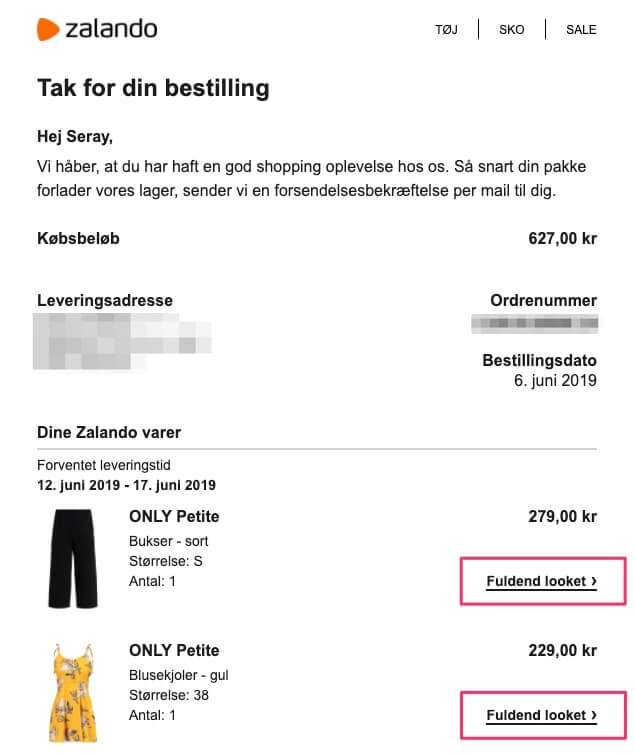
Upsell Email
Upselling is a sales technique used to encourage the buyer to spend more money. The goal is to sell them additional products or upgraded versions of the ones they brought in the past thereby increasing your average order value.
Amazon is an excellent example of applying the cross-sell and upsell in email marketing. Look how the confirmation email you receive contains product recommendations based on your purchase with thumbnail images and links to that product’s page.
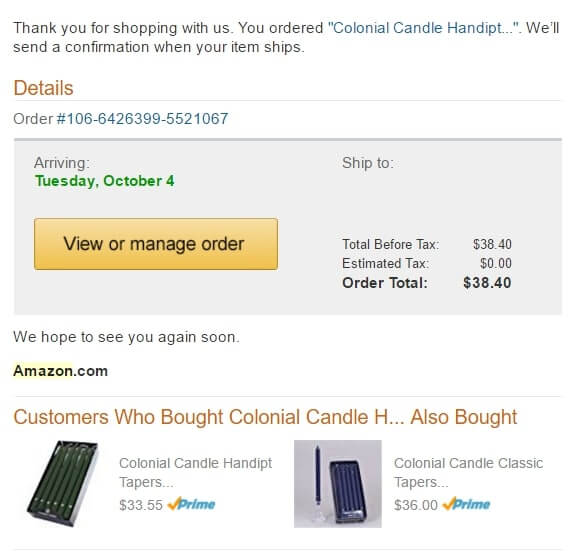
Win-Back Email
In the eCommerce world, you’ve probably experienced the case when you invest time and effort to get loyal customers only to see them stop engaging with your store.
What if I say you can get them back just by using email marketing?
A win-back email campaign is a list of emails created to focus on re-engaging inactive customers or subscribers.
I really like this email from The Bakerista, which has a straightforward, classy design, going with a compelling incentive.
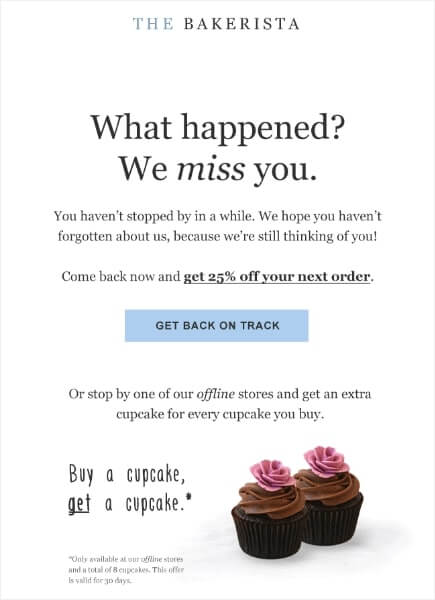
Survey Email
Sending a survey email to your subscribers is a great method of getting valuable information to inform how you run your business. There are many types of surveys you can use in different situations such as NPS or customer satisfaction surveys.
Here’s a good example of a survey email from Neil Patel. Simple, but still effective.
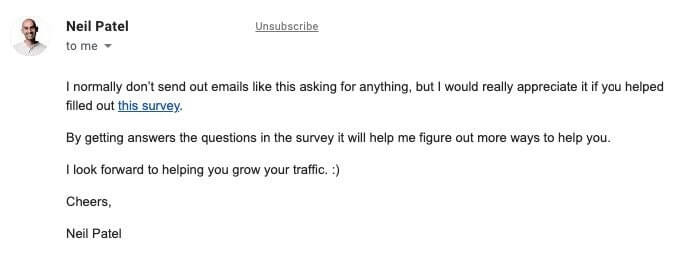
Thank You Email
A thank you email is an email message sent to a customer when they trigger it. The most common triggers are new sign-ups for a newsletter and newly completed purchases.
However, there are more occasions to say “thank you” to your subscribers and use this email for promotional purposes as well.
Hudson’s Bay is a good example of a thank you email for customer purchases.
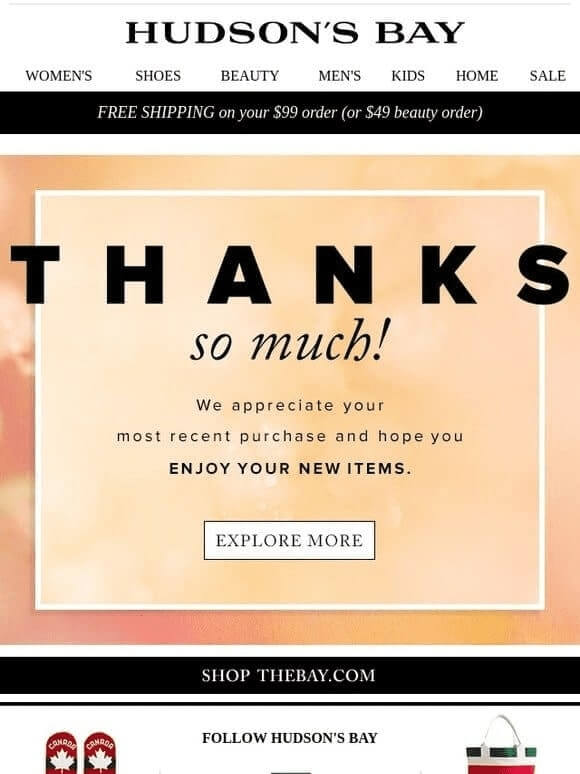
The beauty of a thank you message is that you can send it throughout the customer life cycle. Of course, no one is offended by gratitude, so if you prepare an email to your customers, consider if it’s a good opportunity to say, “Thanks.”
Some bonus eCommerce email marketing tips for you
Let’s look at the top five email marketing tips to help improve your email campaign effectiveness.
- Create a welcome sequence: A series of emails thanking people for signing up. It will introduce them to your business and outline what they can expect from your emails
- Automate emails at key touchpoints: Use the email service to set up emails that are triggered when a customer takes a specific action (For example, when a customer finishes the checkout process or abandons their cart, etc)
- Choose the right email sending frequency: Choose the suitable time frame and frequency to send emails which will not annoy your readers and can still keep in touch with them
- Plan ahead: Map out crucial emails in advance. That means you won’t end up scrabbling around trying to come up with something to send weekly
- Segment your list: Send personalized emails that cater to specific interests and needs of customers. It is always more effective than unsegmented emails
Conclusion
Regardless of how many new, cutting-edge marketing channels arise, email refuses to be supplanted. Used by thousands of businesses of all sizes worldwide, email marketing is one of the primary drivers of traffic and sales to any online store.
Don’t miss your chance to take advantage of this powerful tool. With minor improvements, you can increase your revenue almost effortlessly.
Binh is a content executive at Mageplaza.com, she understands the value of content marketing lies in the engagement between the customers and companies. Her wish is to bring a unique voice, different perspectives, and new light for every audience. She’s also a cat-lover and local conservationist.